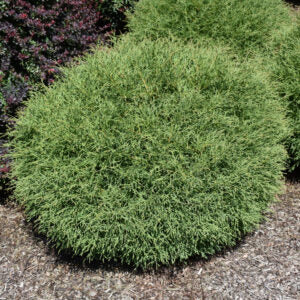As the leaves change colors and the air gets cooler, you might notice your arborvitae shedding its inner needles. If you’re a proud arborvitae owner, this can be a bit alarming at first – but fear not! This phenomenon is a natural process and a sign that your tree is gearing up for the cooler months ahead. Let’s dive into the fascinating world of arborvitae shed and help you understand when it’s just a seasonal wardrobe change and when it’s time to take action.
What Is Arborvitae Shed?
Arborvitae shed, also known as “fall needle drop,” is a natural process where the inner needles of the tree turn yellow or brown and eventually fall off. This shedding is a normal part of the tree’s growth cycle and happens once a year, typically in the fall. It’s similar to how deciduous trees lose their leaves in autumn, but instead of the entire foliage dropping, only the inner, older needles of the arborvitae are shed.
Why Does Arborvitae Shed Happen?
There are a few reasons why arborvitae shed their needles in the fall:
- Natural Aging Process: Just like us, trees age! The inner needles of an arborvitae are the oldest, and after serving their purpose for several years, they reach the end of their life cycle. Shedding these older needles allows the tree to direct its energy toward maintaining healthy, new growth.
- Seasonal Preparation: As winter approaches, trees adapt to conserve energy and resources. By shedding older needles, arborvitae reduce their water and nutrient needs, which helps them survive the colder months. This process ensures that the tree is well-prepared to face the winter and emerge strong and healthy in the spring.
- Healthy Growth: Shedding helps the tree maintain its health by allowing air and light to reach the inner branches. This reduces the chances of disease and promotes better growth overall.

When to Be Concerned About Arborvitae Shed
While fall needle drop is a normal occurrence, there are times when you should take a closer look at your arborvitae to make sure it’s not experiencing stress or other issues:
- Excessive Browning: If you notice that the browning is occurring on the outer tips of the branches or seems to be spreading rapidly, it could indicate a problem such as drought stress, pest infestations, or disease.
- Shedding at the Wrong Time of Year: Arborvitae shed typically happens in the fall. If you notice significant needle drop during other seasons, it may be a sign of stress or an environmental issue.
- Complete Branch Browning: If entire branches are turning brown and falling off, this might be more than just a seasonal shed. It could be a sign of root problems, disease, or damage from pests. In this case, it’s a good idea to investigate further or consult with a tree care professional.
How to Keep Your Arborvitae Healthy
- Watering: Make sure your arborvitae gets enough water, especially during dry spells in late summer and fall. Deep watering once a week should be sufficient, but be cautious not to overwater, as arborvitae don’t like “wet feet.”
- Mulching: Apply a layer of mulch around the base of the tree to help retain moisture and regulate soil temperature. This will protect the roots during winter and keep your arborvitae healthy.
- Fertilizing: While arborvitae generally don’t need much fertilization, a slow-release, balanced fertilizer in the early spring can give them a little extra boost. Avoid fertilizing in the fall, as this can encourage new growth that won’t harden off before winter.
- Pest Check: Inspect your arborvitae regularly for signs of pests such as bagworms, spider mites, or aphids. Catching these pests early can help prevent more severe damage.
In Conclusion
Arborvitae shed in the fall is a completely natural process and a sign that your tree is adapting to the changing seasons. It’s just your tree’s way of saying, “I’m getting ready for winter!” As long as the shedding is limited to the inner needles and happens during the fall, you have nothing to worry about. However, if you notice unusual shedding patterns or browning on the outer branches, take a closer look to make sure your tree is healthy and thriving.
By providing a little TLC, your arborvitae will continue to be the beautiful, evergreen superstar of your landscape all year round!
Shop Our Evergreen Trees and Shrubs:
-
 Snow N Summer Star-Jasmine$17.00
Snow N Summer Star-Jasmine$17.00 -
 Guaje Huaje River Tamarind Miracle Tree Leucaena Leucocephala Live Plant$34.97
Guaje Huaje River Tamarind Miracle Tree Leucaena Leucocephala Live Plant$34.97 -
 Soft Serve® Falsecypress, 3 Gal.
Soft Serve® Falsecypress, 3 Gal. -
 Soft Serve® Gold Falsecypress, 3 Gal.$59.99
Soft Serve® Gold Falsecypress, 3 Gal.$59.99 -
 Moonshadow Wintercreeper$74.99
Moonshadow Wintercreeper$74.99 -
 Emerald Gaiety Wintercreeper$74.99
Emerald Gaiety Wintercreeper$74.99 -
 Blue Star Juniper$71.99
Blue Star Juniper$71.99 -
 Fire Chief™ Arborvitae$64.99
Fire Chief™ Arborvitae$64.99 -
 Mr. Bowling Ball Arborvitae$61.99
Mr. Bowling Ball Arborvitae$61.99 -
 Hino Crimson Azalea$56.99
Hino Crimson Azalea$56.99 -
 Tradition Azalea$56.99
Tradition Azalea$56.99 -
 King’s Gold Falsecypress$66.99
King’s Gold Falsecypress$66.99 -
 Mops Falsecypress$66.99
Mops Falsecypress$66.99 -
 Soft Serve® Gold Falsecypress$69.99
Soft Serve® Gold Falsecypress$69.99 -
 Soft Serve® Falsecypress$66.99
Soft Serve® Falsecypress$66.99 -
 Blue Pacific Shore Juniper$56.99
Blue Pacific Shore Juniper$56.99





